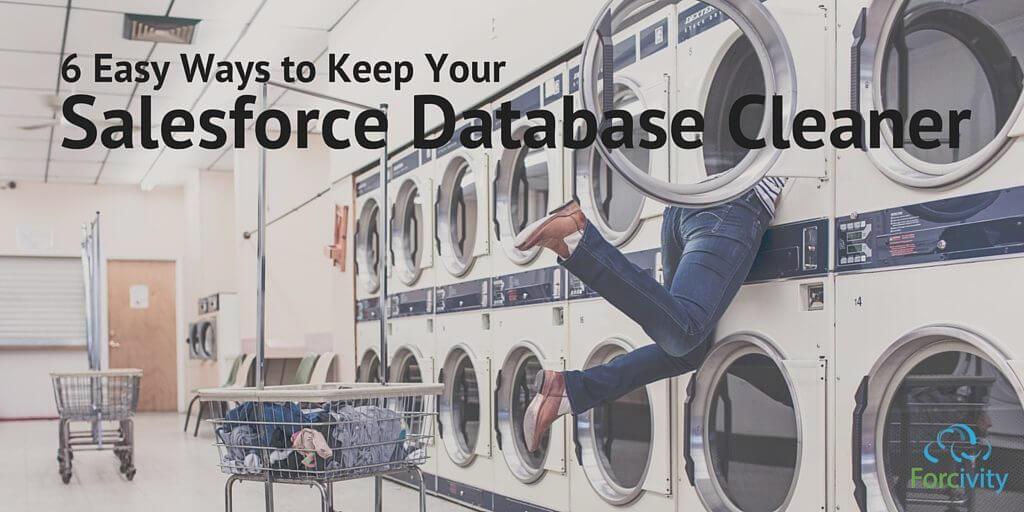6 Easy Ways to Keep Your Salesforce Database Cleaner
Dirty data is the culprit of all sorts of issues including declined system performance, false reporting and negative customer service engagements. We all know that cleaning your data is vitally important, however it is also about as fun as doing laundry. (My apologies, if you think doing laundry is fun!) However, there are some easy things you can do to help keep your Salesforce database cleaner and the best part is you won’t have to go searching for that one missing sock.

1. Bye-bye Duplicates
Having a duplicate record in your database can cause you more than just seeing double in your reporting. It can wreak havoc on your sales representatives and customers too.
Sales reps odds are set against them when they are trying to manage an account with vital information found in duplicate, separate records. It would be like having to look in one cookbook app to get the list of ingredients and then another app to find the baking instructions – Julia Child would have never approved that!
There are many tools available on the Salesforce AppExchange to assist in the seeking, destroying and merging of duplicate records such as: Data Cleanse, Duplicate Check and Cloudingo – just to name a few.
However, the first and most important step in getting rid of duplicate records is to stop creating them in the first place! Make sure your organization has a best practices procedure for record creation that requires searching before creating a new record. And train to that procedure. (See #4 User Training.)
2. Revisit Qualified Lead Definition- Often!
When did you define what a qualified lead was for your business? If you can’t remember or if it was longer than 90 days ago…you need to revisit the definition. If your business has a shorter sales cycle, you may need to revisit it even more frequently then once a quarter.
With any smart marketing or sales program, you are constantly reexamining the success metrics associated with conversion rates. What characteristics and demographics that initially qualified a lead, may not in fact be the same characteristics and demographics of those leads that converted into sales opportunities. Continuing further down the funnel; does your definition hold strong for those won opportunities and those that crossed the finish line?
Every software or application has upgrades to keep it current. Make sure your qualified lead definition is scheduled for frequent upgrades, so you are providing your sales representatives with the strongest qualified leads possible.
3. Remove the @bogus.email Addresses
We have all seen them…the [email protected] or the [email protected]. Besides causing your marketing and sales team frustrations – its more junk data clogging up your database pipes.
If your business uses a Marketing Automation platform like, HubSpot or Marketo to send your emails, you have the ability to sync your data with Salesforce and automatically remove any bounced or undeliverable email addresses – helping to keep your database pipes free of some unnecessary gunk (highly technical term!).
If you haven’t done so already, you should as it is required in many cases to implement a Double Opt-In Process for all of those who sign up to receive your emails. This will help to eliminate fake email addresses from getting into your database pipes in the first place and send them where they belong, down the drain.
4. User Training (Wash, Rinse and Repeat.)
Step 1: Train. Step 2: Train again. Step 3: Train some more. Step 4: Provide a refresher on the training. Step 5: Did we mention, the need to train?
Sure, we all learned geometry in school. But many of us, couldn’t calculate the hypotenuse of a triangle if our life depended on it. Simply, because most of us don’t use geometry in our every day lives, we get rusty at it or forget it all together. Salesforce training should be thought of the same way. When not used regularly, overtime, Salesforce knowledge and skills decline. Now is the time to bust out that best practice procedure for record creation we talked about in #1 and put it to use in your next training class.
Training once, is not enough. Frequent refresher training helps to ensure your Salesforce users are kept up to date on the best practice associated with performing their required tasks in Salesforce.
Don’t forget, to tell or better yet show, those you are training, why the training is important (i.e. increased productivity, higher customer satisfaction, cleaner reporting, a decreased likelihood of your Salesforce Administrator pulling their hair out, etc.) Elect an executive sponsor to continue to communicate and check in with users to reinforce the best practices and help ensure adoption. If you want to take it a step further, there is an app for that – a free app, with badges for rewarding user behavior! Check out The Best Salesforce Apps You’re Probably Not Using and scroll down to the section on Redwing.
5. Make Free Form Fields Not so Free Form
Sure there is a time and place for free form fields…call notes is a great example. It gives the user the ability to type in things like what they discussed with a customer or what they will discuss on their next call. However if you want a field to be reportable, then you don’t want it to be free form.
So when you are tired of reading through the call notes to discover what the final outcome of the call is. You may decide to add in a call disposition dropdown menu, providing codes or descriptions of the final outcome of the call, for users to choose from. Drop downs ultimately help to save the user time, provide you with reportable information, and get’s rid of inconsistencies.
Eliminate Inconsistencies? Inconceivable! Not with dropdown menus. During your next sales meeting, ask your team to write down how they would abbreviate ‘United States’ and then have them pass their papers forward and take a read and you will see why drop down menus are a must. Your Honor, we rest our case!
6. Implement a DNR (Do Not Resuscitate) Policy
When is the last time that prospect or customer actual engaged with you? Has it been over 6 months since a rep has been able to make live contact with them? Have they not opened a single email in over a year? It’s probably safe to say that relationship has flat lined.
If you haven’t done so already, now is as good a time as any to implement a Do Not Resuscitate policy, aka remove the inactive contacts from your database. Define a list of criteria that prospects and customers must reach (it may be a different criteria for each) to be removed from the database. Make sure you revisit and refine your definition and purge inactive leads and contacts often. Out with the old and in with the new and hopefully more engaged!
For those of you that are still engaged with us in this article, we have thrown in a couple of bonus tips as a reward for good behavior.
7. Protect Yourself from Yourself
Everyone has heard of the saying “Making it rain!” and when it’s used in reference to money – that is a great thing! However, not when it’s used in reference to Salesforce admin rights.
Think of and treat admin rights as an exclusive VIP membership and with that membership comes a lot of responsibility. Do they know how all of the fields, accounts and objects are related? Do they understand the different department requirements and data needs? For example, the sales department may not need the information they are thinking of hard deleting, but the head of finance does!
Its best to set a list of criteria that one must meet in order to be awarded admin rights. As the saying goes, trust is earned not given and the same should be said for admin rights.
8. Make Sure Everyone has a Place to Play
Oil and water don’t mix – and neither should your testing data and production environments.
A sandbox, as defined by Salesforce developers, is a testing environment, specifically used for testing application functionality before deploying to production or releasing to customers. The key word there is TESTING.
Having a testing specific environment, helps to ensure testing data isn’t uploaded into your “live” production environment – potentially filling your database with more junk data. And the whole premise of this article to make your database cleaner…not dirtier! If you don’t have a sandbox, create one!
Follow and like us on social to see all the great and fun things Apps Associates has up our sleeves.
Speaking of fun…did you notice the obscure movie reference we made in this post? Be one of the first ten people to tweet @Apps Associates the name of the flick and we will send you a mystery prize.
